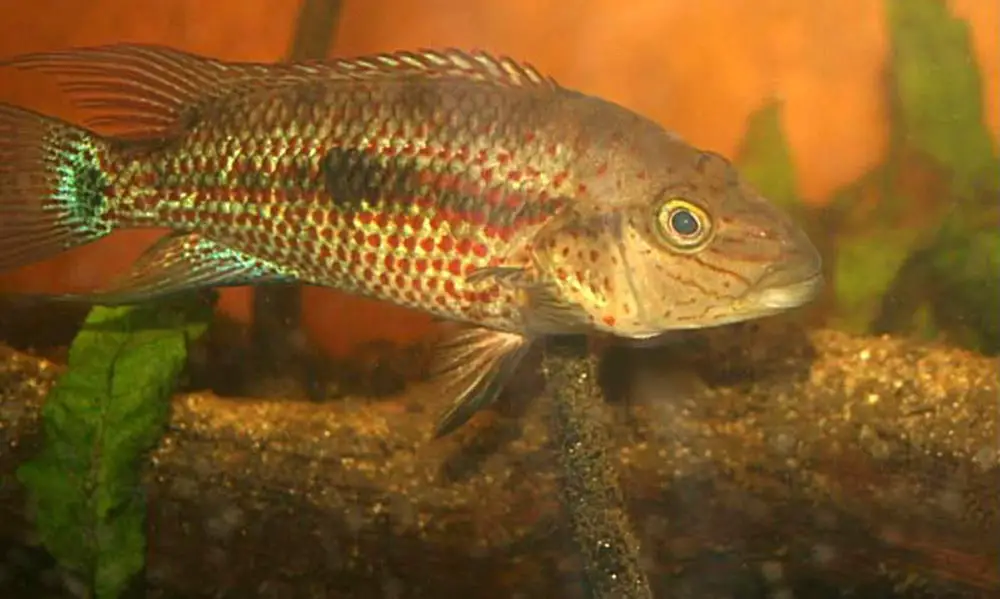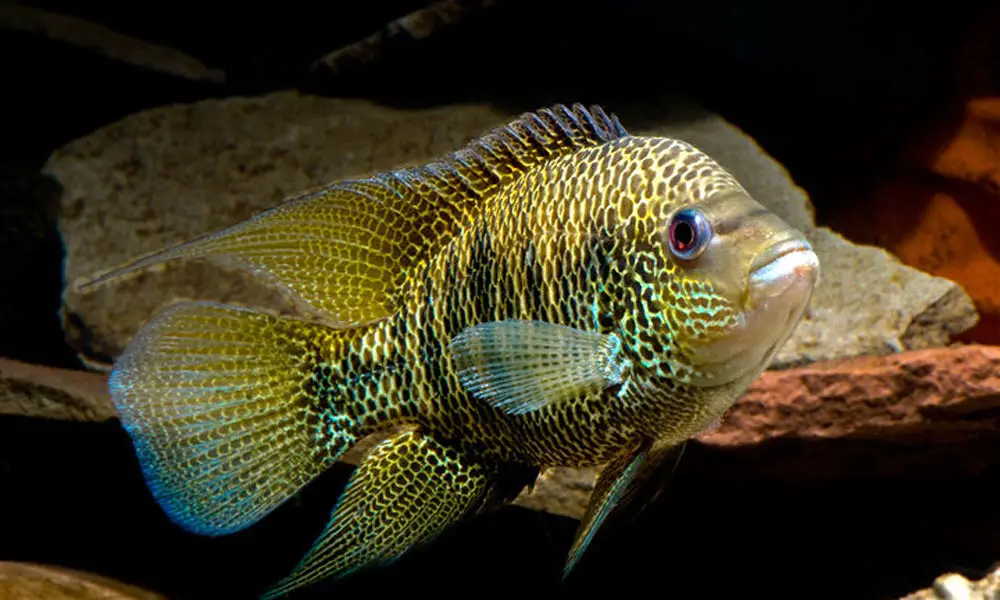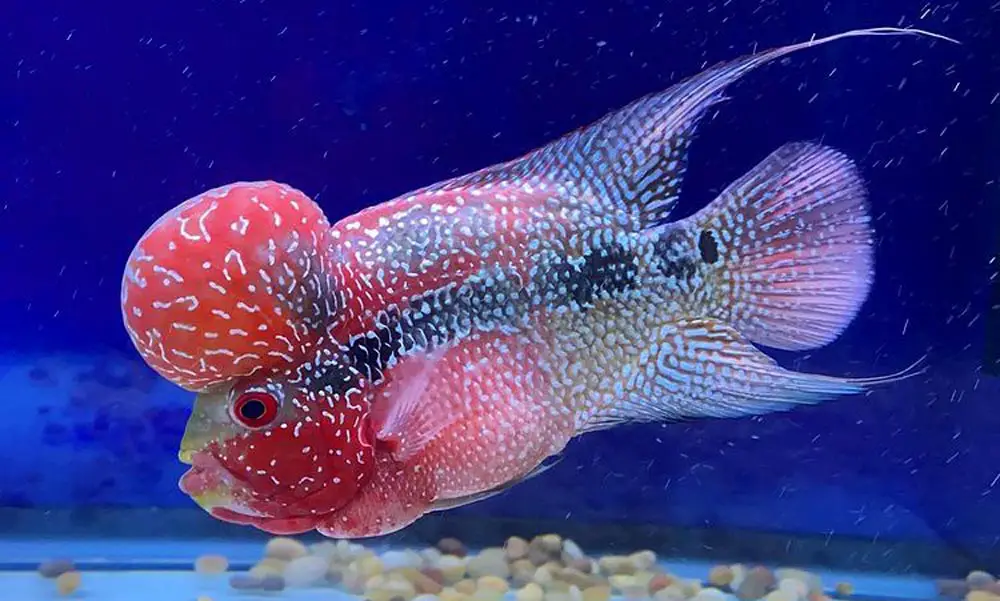If you find yourself mesmerized in front of those beautifully colorful fish called Cichlids at your local pet store, don’t be surprised. These intelligent species are among the most brightly colored, energetic, and hardy freshwater fish in the aquarium for years! You can find hundreds of Cichlid species to keep and culture. Though cichlids come from many different regions and come in various sizes, they are more aggressive than other tropical fish.
Before deciding on which cichlids to add to your aquarium, you may want to know “what are the most aggressive cichlids?” I have rounded up a list of the world’s top 10 most aggressive Cichlids.
Top 10 Most Aggressive Cichlids(SA & CA)
#1 Dovii Cichlid (Parachromis Dovii)

The Dovii Cichlid is the most aggressive Central American cichlid, which can be found on both slopes of Honduras, Nicaragua, and Costa Rica. In the wild, it’s also known as the infamous Wolf Cichlid or Guapote, an important local commercial fishery.
The Dovii Cichlid most commonly has a beautifully deep body. The females have a base gold or yellow coloration and tend more prominent during breeding. The mature males tend to have a more blue tone, and the dominant ones will naturally be brighter than that.
Anchor notice: The darker the male Dovii Cichlid is, the more unhealthy that it is in the aquarium.
As a game fish, the Dovii Cichlid grows to a length of 28″ when mature, a huge beast. They are not so aggressive when they are small, but once they reach 6″ or larger – things change drastically! Their fierce, powerfully aggressive nature with large teeth and muscular body can quickly bring damages to you and other tank mates.
| Scientific Name: | Parachromis Dovii |
| Origin: | Central American |
| Temperament: | Highly Aggressive |
| pH: | 7.0 – 8.0 |
| Temperature: | 75–81 °F |
| Minimum tank size: | 75 gallons |
| Size: | 28.5 inches |
| Diet: | Carnivorous |
#2 Umbee Cichlid (Caquetaia Umbriferus)

The Blue and Black Umbee Cichlids originate from South America, while the Green Umbee Cichlids are native to Central America. Due to its aggressive nature and characteristic blue or turquoise spotting, the Umbee Cichlid is one of the most popular species for a Cichlid tank.
As a fierce predator in the New World cichlids, the male Umbees (K. umbriferus) can reach lengths of 24″ in captivity. Some well-maintained aquarium specimens may grow even larger. Females can grow up to 20″ in length.
In the aquarium, you may see these guys are quite cute and a bit shy when they are young. However, when they grow larger, the tides turn – their retiring nature disappears, they grow stronger, get a large mouth with teeth, and become ferocious as time goes on, which is why they’re called “Blue Freckled Monsters.”
| Scientific Name: | Caquetaia Umbriferus |
| Origin: | South America, Central American |
| Temperament: | Highly Aggressive |
| pH: | 6.5 – 7.5 |
| Temperature: | 72 – 80 °F |
| Minimum tank size: | 180 gallons |
| Size: | 24 inches |
| Diet: | Carnivorous |
#3 Sieve Cichlid (Nandopsis Grammodes)

The Sieve Cichlid, also known as Mini Dovii Cichlid or Lesser Wolf Cichlid, as its name suggests, is literally a Dovii Cichlid, just a small package. Unlike many other neotropical cichlids, it is a Mexican species.
Mini Doviis are attractive fish. It is most recognized for its large head, and ample red-orange spots are clearly visible at its head and the entire body. There is an irregular black stripe that extends into the mid-line.
Compared with the Parachromis Dovii that can grow up to 28″, the Mini Dovii Cichlid will only reach up to 12″ in length. What’s more, they grow slower than most of the CA cichlids, especially when they reached 8-10″. However, their speed and persistence make them among the toughest and skilled fighters when they battle with their tankmates. Believe it or not, they will go for their enemy’s eyes and throats when they were defending their territory.
| Scientific Name: | Chiapaheros Grammodes |
| Origin: | Central American |
| Temperament: | Semi-aggressive |
| pH: | 6.0-8.0 |
| Temperature: | 70-82 °F |
| Minimum tank size: | 75 gallons for a single adult, 125+ gallons for a pair |
| Size: | 12 inches |
| Diet: | Carnivorous |
#4 Black Nasty Cichlid (Nandopsis Haitiensis)
The Black Nasty Cichlid is a large and neotropical cichlid, commonly known as the Haitian Cichlid, which originates from the fast-moving freshwater lakes and rivers in Haiti and the Dominican Republic.
Black Nasty Cichlids are generally a base silver over the entire body, but with high contrast pattern on the head and fins. They can reach sizes of up to 15 inches.
Well, this species has a well-earned name, the “Nasty” part of its name is all. Both males and females are nasty, ferocious, and powerful. Be careful with males when you mix them with other fish in a community tank, which will eat almost everything they are offered.
| Scientific Name: | Nandopsis Haitiensis |
| Origin: | Central American |
| Temperament: | Aggressive |
| pH: | 6.5-8.0 |
| Temperature: | 68-73 °F |
| Minimum tank size: | 75 gallons for a single adult, 125+ gallons for a pair |
| Size: | 15 inches |
| Diet: | Omnivore |
#5 Green Guapote Cichlid (Nandopsis Beani)

Nandopsis Beani is the hardest-to-obtain cichlids for hobbyists because they are now quite rare. It’s known as the green guapote Cichlid, which originates from the Pacific slope of Mexico, is another wonderful ‘monster fish’ South and Central American Cichlids.
Their characteristic green with the yellow coloration across the dorsal surface and the fins is more common. This species shows the actual color depending on the mood, which ranges from dark greens to yellow hues.
Nandopsis Beani will generally grow up to 11″. Like most of the aggressive Cichlids, they are territorial species and will chase and kill without taking a break. I highly recommend that you keep them with cichlids that can defend themselves because they are natural-born fighters and not good at fighting back.
For the success of keeping green guapote cichlids, you should know that they are very susceptible to bloat if you have poor water conditions.
| Scientific Name: | Nandopsis Beani |
| Origin: | Central American |
| Temperament: | Aggressive |
| pH: | 7.4 – 8 |
| Temperature: | 74 – 78 °F |
| Minimum tank size: | 75 gallons for a single adult, 300+ gallons for a pair |
| Size: | 11 inches |
| Diet: | Omnivore |
#6 Red Devil Cichlid (Amphilophus Labiatus)
The Red Devil Cichlid is an excellent choice for a hobbyist with the desire to keep a large, charismatic fish. As one of the large Central American cichlids, they can make your aquarium colorful and more personable.
The Red Devils are known for their bright coloring and thick, orange lips. Their more pronounced appearance is due to environmental factors such as diet or sunlight exposure in the wild. Some colorful specimens come with a black-tipped tail and fins, full of personality.
Red Devil Cichlids are very aggressive and owner-conscious towards other fish species. With their razor-sharp teeth and jaws, they will kill tankmates who can’t defend themselves, a true tough killer.
| Scientific Name: | Amphilophus Labiatus |
| Origin: | Central American |
| Temperament: | Aggressive |
| pH: | 6.8-7.2 |
| Temperature: | 72-77 °F |
| Minimum tank size: | 55 gallons |
| Size: | 12 inches |
| Diet: | Omnivore |
#7 Butterikoferi Cichlid (Tilapia butterkofferi)
The Butterikoferi Cichlid, also known as the Zebra Tilapia, is a unique freshwater fish that natives to the river systems of Western Africa. With its large size and attractive markings, this is one of many great Africa cichlids for your next aquarium pet.
The African Buttikoferi BumbleBee Cichlids have a series of black and white vertical stripes like bees. The name itself is enough to tell. They are herbivores, love plants and will search out either for refuge from other predators or as food sources. However, they are not sweet creatures and should never be trusted.
Butterikoferi Cichlids are known for their strong, crushing bite and ripping off other fish from time to time. I’ve been on this boat many times before but never had any close encounters with these guys until last week when one of them gave me 9 stitches! Don’t forget that these guys usually grow up to 16″, allowing them to compete with Doviis and Red Devils.
| Scientific Name: | Tilapia butterkofferi |
| Origin: | Western Africa |
| Temperament: | Highly Aggressive |
| pH: | 7.8-8.6 |
| Temperature: | 72-82°F |
| Minimum tank size: | 70 gallons |
| Size: | 16 inches |
| Diet: | Omnivore |
#8 Jaguar Cichlid (Parachromis Managuense)

The Jaguar cichlids, also known as the Guapote tigres, are native to freshwater habitats in Central America. As a large species of CA Cichlid, this beautiful species is a popular and fun companion for the more experienced fishkeeper.
The Jaguar Cichlid comes with its drab silver scales and dark black markings that camouflage the oval-shaped body in the water like a Jaguar pelt. Dorsal and anal fins are supported by spiny rays, which protect them from other predatory fish.
The reason we put these monsters on the list is obvious: they are recognized as cousins to the Dovii. Now you can imagine what they will do to other fish getting in their space. Not mentioned that the average size of an adult Jaguar Cichlid is around 14-16 inches. With their pharyngeal teeth, big mouth, and aggressive behavior, they will sometimes fight to the death.
Author notice: Jaguars, when kept in appropriate-sized tanks, can be rarely aggressive. Generally, the recommended minimum tank size for a male jaguar is 125 gallons.
| Scientific Name: | Parachromis Managuense |
| Origin: | Central America |
| Temperament: | Aggressive |
| pH: | 6.0-8.0 |
| Temperature: | 70-82°F |
| Minimum tank size: | 125 gallons |
| Size: | 16 inches |
| Diet: | Omnivore |
#9 Istlanum Cichlid (Cichlasoma Istlanum)
Istlanum Cichlid, the other hardest-to-obtain Cichlid on the list, originates from the Balsas river system in Mexican. Like most cichlid species, they come with common characteristics: brilliant colors and personality habits.
The body of this species is a yellow coloration base with several black spots along the middle part of the flanks. A dark green head is clearly visible, and iridescent speckles are in the translucent fins.
Male istlanums can grow up to 10″ in length, females always stay smaller. Some specimens can be passive, while others are extremely aggressive. The Istlanum Cichlid is a tough cichlid that resembles the Umbee cichlid.
| Scientific Name: | Cichlasoma Istlanum |
| Origin: | Central America |
| Temperament: | Aggressive |
| pH: | 7.2 – 7.6 |
| Temperature: | 74 – 80 °F |
| Minimum tank size: | 75 gallons |
| Size: | 10 inches |
| Diet: | Omnivore |
#10 Flowerhorn Cichlid (Cichlasoma sp.)

The Flowerhorn Cichlid(generically called luohans) can’t be found in the wild because it’s a hybrid species and has been bred entirely in captivity over time. Due to their vivid colors, forehead hump, and personality have become very popular with hobbyists for years.
The Flowerhorn Cichlid is most recognizable for its large and vibrant-colored nuchal hump (Aka kok) on the forehead, the most noteworthy feature of this species, and can usually be more distinctive on males.
Flowerhorn cichlids are very aggressive and territorial, are capable of dominating just about anything in the tank. They can grow to be around 12″, some specimens can reach 18″ in length. The recommended minimum tank size for flowerhorn cichlid is around 75 gallons, and it’s not suitable for a community tank.
| Scientific Name: | Cichlasoma sp |
| Origin: | Central America |
| Temperament: | Semi-Aggressive |
| pH: | 7.4–8.0 |
| Temperature: | 80–85 °F |
| Minimum tank size: | 75 gallons |
| Size: | 18 inches |
| Diet: | Omnivore |
Final words
Dovii Cichlid pound for pound is the king on the list of top most aggressive cichlids. Of course, each species is different, depends on individual fish more so. Let me know what you think of this list in the comments.

Red terror cichlid. Chicolosoma Festae was omitted. I have had red terror that have killed a couple of your 10 meanest. Honorable mention:RedTettor.
Any terror i had green terrors that nearly wiped out tank wr had to get rid of them
NO OSCAR CICHLID??!! Oscars and very aggressive fish and it shd be at least in the top 10
Oscars are not overly aggressive fish, and some may not be able to hold their own against other cichlids.
I have kept an Oscar with other SA cichlids, and I’ve never had any aggression problems.
Oscars are only aggressive towards tiny fish. Every fish on this list are far more aggressive than Oscars. Oscars are too slow. They eat anything smaller but a fish it’s size would bully it especially any fish on this list.
What about trimec
My Flowerhorn Cichlid killed everything in the tank from Oscars to Red Devils and even killed a Butterikoferi Cichlid the first day in the tank should be higher than the Red Devil and Butterikoferi Cichlids it’s a monster.
Absolutely agree with you. I had lot of these fish… I feel the Flower horn was by far most aggressive.
Hemichromis Fasciatus should be number 1 ANY species of cichlid Dovii and all the others included on this list around the same size or a little larger than the Hemichromis would be annihilated don’t believe me research it and Amphilophus Chancho on many occasions have been seen backing down Dovii and Umbees and don’t get as long but weigh as much again research it!
Eye Biter for sure should be in the top 10.
Most people don’t understand any of these fish can kill the other. Especially when adding to an existing tank. Rarely does the established fish loose in a battle. Pound for pound certain African cichlids can hold their own..